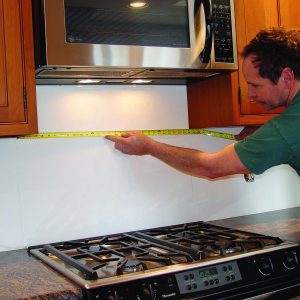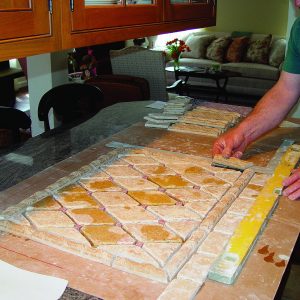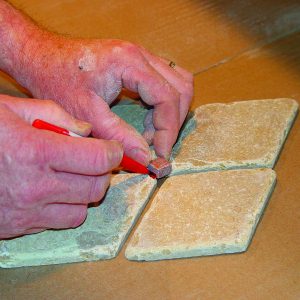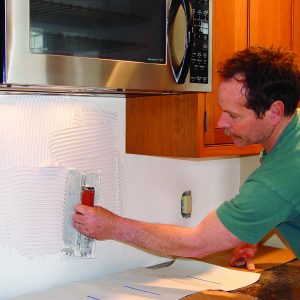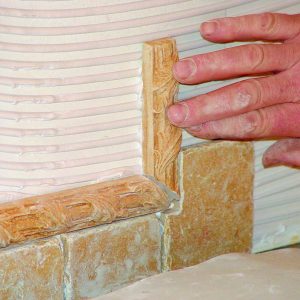Tiling a Backsplash
Durable and decorative, a tile backsplash dresses up the wall behind a sink or behind a stove.

Synopsis: This excerpt from Tom Meehan’s tiling book, Working with Tile, details the process of installing a tumbled marble splash with mastic over drywall. Layout, installation, and grouting are all covered with photos and text. A sidebar offers tips for tiling around an electrical outlet.
Also, don’t miss Tom Meehan’s Build Like a Pro video series, How to Tile a Backsplash.
Saturday is estimate day at our store, Cape Cod Tileworks. Of the five or six estimates we do on Saturday mornings, at least a third of them are for kitchen backsplashes. Whether the room is new or old, a backsplash is a great opportunity to express a kitchen’s qualities, including color, creativity, boldness, subtlety, and craftsmanship. If you haven’t done a lot of tiling, a backsplash is a great way to get your feet wet.
Layout: a road map for the backsplash
Once the tile has been selected, the next step is layout. For this project, my client chose tumbled-marble tile. Its coarse natural texture makes a particularly nice contrast to a smooth, shiny kitchen countertop, such as granite.
The layout for most of this backsplash is fairly simple: three courses of 4-in. by 4-in. tile topped off by a narrow border; a filler course takes care of the space between the border and the wall cabinets. The challenging part is the patterned area behind the stove. Taller and more intricate than the rest of the backsplash, this area requires a layout that is dead-on accurate. My first step is measuring the exact dimensions of that space.
Over the years, I’ve found that doing the layout directly on the wall doesn’t work well. Instead, I draw a full-size layout of the patterned area on a sheet of cardboard. Then I cut and arrange all the tiles as needed to fit the layout. I don’t start to set tile on the wall until the test-fit is complete. This backsplash features small square dots at the intersections of the diamonds. At this point, I mark and cut these types of elements as well.
If a backsplash is interrupted by a window, it looks best if the tiles on each side of the window are the same size, which often means using partial tiles elsewhere. I plan the size and location of these partial tiles to please the eye.
Electrical outlets have to be incorporated into most backsplashes. A symmetrical layout around an electrical box looks best and is the easiest to cut. In extreme cases, the box can be moved for a proper-looking layout.
Install the tile in the right order
Before mud and mastic start flying, it’s critical to protect appliances, countertops, and other finished surfaces. For this installation, a rubber shower-pan liner and a piece of cardboard protect the countertop and floors. The rubber liner is great because it can take a little impact if something is dropped on it. It also stays put, unlike a plastic drop cloth.
When I’m ready to set tile, I spread all-purpose mastic on the wall using a trowel with 1 ⁄4-in. by 1 ⁄4-in. notches. Because the tumbled marble for this backsplash is a fairly light color, I used non staining white mastic, which prevents the tile from spotting or darkening.
I set the bottom course of tiles for the backsplash first, after putting spacers under the tiles to keep them 1⁄8in. Above the counter. If the counter has to be replaced in the future, this space provides enough room to slip in the new countertop without disturbing the backsplash.
To install each tile, I press it tightly against the wall about 1⁄4in. from its final position, then slide it in place to ensure a tight bond. With the bot-tom course in place, I turn to the trickiest part of the job, the patterned area behind the stove. Border pieces go in first. To create visual interest, I like the border to stand slightly proud of surrounding tiles, a subtle strategy that’s not difficult to do. Before installing each border piece, I butter the back with mastic. When the tile is pressed in place,the extra mastic makes the border stand out slightly from the rest of the tile. Setting a few of the regular backsplash tiles outside the border helps to keep the border pieces straight.
As I place tiles, I make the grout joints roughly 1⁄4in.wide. Because these tiles are irregular, the joint size varies somewhat. Instead of relying on spacers, I shift the tiles slightly as the different sizes require.
For the diamond pattern of the backsplash, I install the tiles in a diagonal sequence to keep them aligned along their longest straight edge. The tiny square accent pieces go in as I set the larger diamond tiles.
Once the stove backsplash is done, the rest of the job goes quickly. The main backsplash is only four courses high,and it’s fairly easy to keep the grout lines level and straight.
As for the cut tiles that fit against the end walls and upper cabinets, I cut them for a tight fit with little or no grout joint. Grout is most likely to crack where different materials meet.
Seal the tile before grouting
I leave the tile overnight to let the mastic set up.The next day, I wipe down the backsplash with a good impregnator/sealer, which helps to protect the marble and acts as a grout release. Grouting tumbled-marble tile is a little more difficult than grouting standard glazed tile. Grout tends to catch and collect along the irregular edges and on the surface of tumbled marble as well as in the relief of the border tiles.
I always use sanded grout with tumbled marble. Sand mixes with portland cement to add body and strength to the grout, making it superior at filling the wide joints between irregular tile edges. Border tiles such as the ones in this project also demand a stronger grout because they sit farther out than the rest of the tile.
I mix a stiff but workable batch of grout that won’t fall out of the joints as I float it on in a generous coat. When all the joints are filled, I let the grout sit until it is firm to the touch, usually 15 minutes or so. Then I wipe the tile with a grout sponge dampened with clean water. I make sure to wring out the sponge before wiping the tile; too much water can dissolve the cement and weaken the grout. When cleaning marble tiles, I pay extra attention to rough spots in the marble and to the patterned areas in the border tiles. These areas may need a little more effort to remove excess grout.
After washing it, I let the grout set up for another 15minutes (less, if the room is warmer than normal). Then I use a clean terry-cloth towel to wipe the grout haze off the tile surface. At this point, I also use a putty knife to remove any grout stuck in corners or in other places where I want to see a clean, straight grout line.
The next day, I do a final cleaning with a good tile cleaner. Because some cleaners corrode or stain, I keep the countertop, stove, and sink protected. A day or two after cleaning, I finish the job by applying sealer to the tile and grout. If the tile is stone (as in this case) and I sealed the tile before grouting, an additional coat of sealer also protects the grout. I apply the sealer with a disposable foam brush and give the backsplash behind the stove a couple of extra coats to protect the tile and grout from grease.
Working around an electrical outlet
Symmetrical coverage looks best when tile meets an electrical box. Mark the edges of the box on surrounding tiles and cut them to fit. Cut the tile so that the ears on the outlets and the switches overlap the edges of the tile. Before installing the tiles around the box, back out the screws that secure the outlets and switches. Longer screws may be necessary to make up for the added thickness of the tile.
For more photos and details on tiling backsplash, click the View PDF button below.

